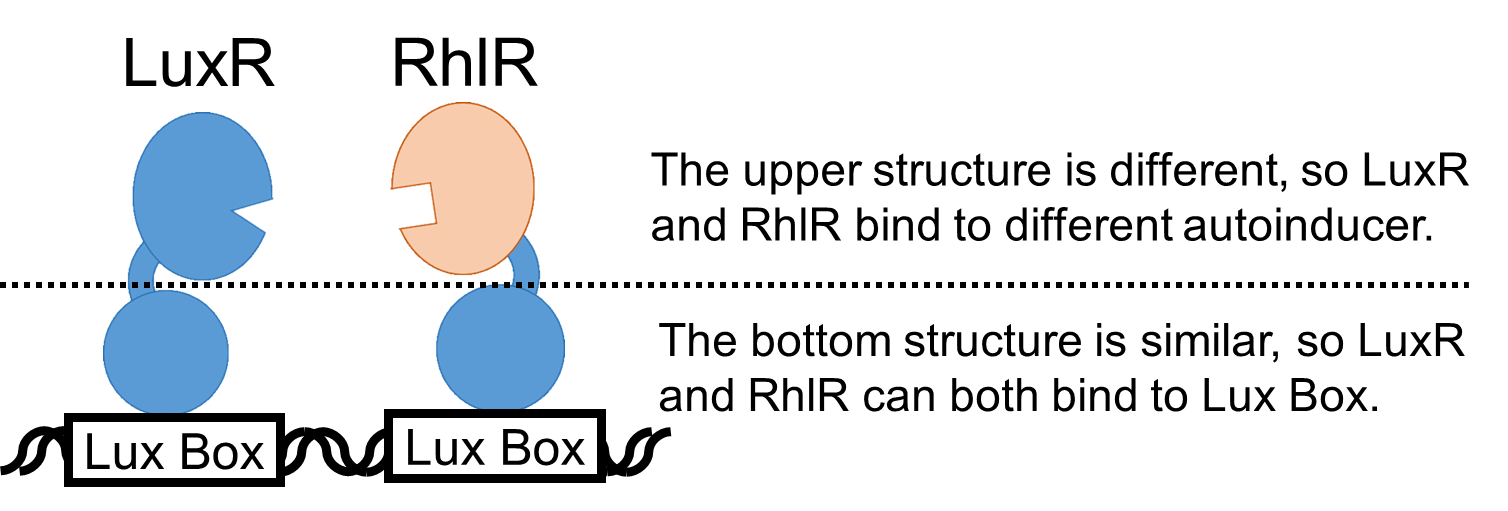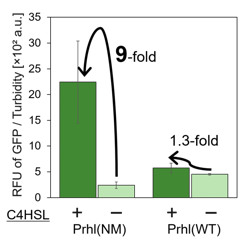Difference between revisions of "Part:BBa K1529310"
| Line 17: | Line 17: | ||
For more information, see [http://2014.igem.org/Team:Tokyo_Tech/Experiment/Prhl_reporter_assay our work in Tokyo_Tech 2014 wiki]. | For more information, see [http://2014.igem.org/Team:Tokyo_Tech/Experiment/Prhl_reporter_assay our work in Tokyo_Tech 2014 wiki]. | ||
| + | ===Improvement and Characterization === | ||
| − | ===iGEM | + | Group: <b>Tokyo Tech 2016</b> |
| − | We | + | |
| + | Author: Yoshio Takata | ||
| + | |||
| + | Summary of Improvement and Characterization: | ||
| + | |||
| + | I. Improved Prhl by iGEM 2014 Tokyo_Tech and characterize RhlR assay | ||
| + | |||
| + | II. Improvement of the wild type Prhl | ||
| + | |||
| + | III. Comparison of the improved Prhl by iGEM 2014 Tokyo_Tech to our original improved Prhl | ||
| + | |||
| + | |||
| + | <span style="margin-left: 10px;">We Tokyo Tech 2016 simulated our final genetic circuits and found that the circuits did not work, because Prhl strength was too weak. (see [http://2016.igem.org/Team:Tokyo_Tech our work in Tokyo_Tech 2016 wiki]). We therefore considered using the improved Prhl (<partinfo>BBa_K1529310</partinfo>,<partinfo>BBa_K1529310</partinfo>) established by Tokyo_Tech 2014, but we noticed that they were inappropriate for two reasons (see [http://2016.igem.org/Team:Tokyo_Tech our work in Tokyo_Tech 2016 wiki]). Then, we decided to improve Prhl Promoter and obtain our original improved Prhl (included in <partinfo>BBa_K1949060</partinfo>) that suited our goal. | ||
| + | |||
| + | <span style="margin-left: 10px;">Our purpose is to create strong Prhl for our final genetic circuits. | ||
| + | This experiment consists of the three parts below. | ||
| + | |||
| + | I. Improved Prhl by Tokyo_Tech 2014 and characterize rhlR assay | ||
| + | |||
| + | II. Improvement of the native Prhl | ||
| + | |||
| + | III. Comparison of the improved Prhl by Tokyo_Tech2014 to our original improved Prhl | ||
| + | |||
| + | The past improved Prhl did not suit for our final circuits and we could create the improved Prhl appropriate to our final circuits. | ||
| + | |||
| + | |||
| + | ====I. Improved Prhl by iGEM 2014 Tokyo_Tech and characterize RhlR assay==== | ||
| + | |||
| + | <span style="margin-left: 10px;">We found that Prhl(RL) (<partinfo>BBa_K1529300</partinfo>) activity was weak and the expression level depended on LVA tag (Fig.1); LVA-tagged proteins are prone to be degraded by cellular proteases. Prhl(LR) (<partinfo>BBa_K1529310</partinfo>) activity was strong and unexpectedly reacted with C12 (crosstalk) (Fig.3). | ||
| + | |||
| + | [[Image:prhl1.png|thumb|center|400px|Fig.1 Comparison of the Past improved Prhl and RhlR ]]<br> | ||
| + | |||
| + | <span style="margin-left: 10px;">The colonies of transformants with a rhlR (<partinfo>BBa_C0171</partinfo>) plasmid looked rough and the growth rate was low(Fig.2-left), while the colonies of transformants with a rhlR-LVA (<partinfo>BBa_C0071</partinfo>) plasmid looked smooth and the growth rate was normal(Fig.2-right). However, the reason for this result is unclear. | ||
| + | |||
| + | [[Image:prhl2.png|thumb|center|400px|Fig.2 The colonies of transformants with a rhlR (left) or a rhlR-LVA right]]<br> | ||
| + | |||
| + | |||
| + | ====II. Improvement the wild type Prhl==== | ||
| + | |||
| + | <span style="margin-left: 10px;">By introducing a single point mutation into wild type Prhl (<partinfo>BBa_R0071</partinfo>) by PCR, we obtained 198 Prhl mutants and chose the two Prhl mutants of which promoter activity was stronger than wild type Prhl(Fig.3). | ||
| + | |||
| + | [[Image:prhl4.png|thumb|center|400px|Fig. 3 RFU of GFP / turbidity of imoroved Prhl mutants]]<br> | ||
| + | |||
| + | The sequences of these tow chosen mutants are shown in experience page. | ||
| + | |||
| + | |||
| + | ====III. Comparison the improved Prhl by iGEM 2014 Tokyo_Tech to our original improved Prhl==== | ||
| + | |||
| + | <span style="margin-left: 10px;">Prhl(NM) was chosen from the many Prhl mutants, and by comparing Prhl(NM) to Prhl(LR), we obtained the result below (Fig.4). The reaction activity of Prhl(NM) to C4 was stronger than that of Prhl(LR), and Prhl(NM) did not react with C12 at all. | ||
| + | |||
| + | [[Image:prhl3.png|thumb|center|400px|Fig.4 Comparison of Prhl(NM) to Prhl(LR)]]<br> | ||
| + | |||
| + | If you want more information, you see [http://2016.igem.org/Team:Tokyo_Tech our work in Tokyo_Tech 2016 wiki]! | ||
<!-- Add more about the biology of this part here | <!-- Add more about the biology of this part here | ||
Revision as of 04:52, 16 October 2016
Prhl(LR)
We newly developed the Prhl(LR) promoter (BBa_K1529310) by improving Prhl promoter (BBa_R0071) which is activated by C4HSL-RhlR complex (Fig. 1).
To characterize the function of this Prhl(LR) promoter, we constructed a part, Prhl(LR)-GFP (BBa_K1529311), by inserting the Prhl(LR) promoter, upstream of a GFP coding sequence.
By using the reporter cells that contain Prhl(LR)-GFP, we measured the fluorescence intensity of the cells induced by C4HSL. (Fig. 3.)
We saw that our new Prhl(LR) promoter was actually activated by C4HSL through an induction assay
For more information, see [http://2014.igem.org/Team:Tokyo_Tech/Experiment/Prhl_reporter_assay our work in Tokyo_Tech 2014 wiki].
Improvement and Characterization
Group: Tokyo Tech 2016
Author: Yoshio Takata
Summary of Improvement and Characterization:
I. Improved Prhl by iGEM 2014 Tokyo_Tech and characterize RhlR assay
II. Improvement of the wild type Prhl
III. Comparison of the improved Prhl by iGEM 2014 Tokyo_Tech to our original improved Prhl
We Tokyo Tech 2016 simulated our final genetic circuits and found that the circuits did not work, because Prhl strength was too weak. (see [http://2016.igem.org/Team:Tokyo_Tech our work in Tokyo_Tech 2016 wiki]). We therefore considered using the improved Prhl (BBa_K1529310,BBa_K1529310) established by Tokyo_Tech 2014, but we noticed that they were inappropriate for two reasons (see [http://2016.igem.org/Team:Tokyo_Tech our work in Tokyo_Tech 2016 wiki]). Then, we decided to improve Prhl Promoter and obtain our original improved Prhl (included in BBa_K1949060) that suited our goal.
Our purpose is to create strong Prhl for our final genetic circuits. This experiment consists of the three parts below.
I. Improved Prhl by Tokyo_Tech 2014 and characterize rhlR assay
II. Improvement of the native Prhl
III. Comparison of the improved Prhl by Tokyo_Tech2014 to our original improved Prhl
The past improved Prhl did not suit for our final circuits and we could create the improved Prhl appropriate to our final circuits.
I. Improved Prhl by iGEM 2014 Tokyo_Tech and characterize RhlR assay
We found that Prhl(RL) (BBa_K1529300) activity was weak and the expression level depended on LVA tag (Fig.1); LVA-tagged proteins are prone to be degraded by cellular proteases. Prhl(LR) (BBa_K1529310) activity was strong and unexpectedly reacted with C12 (crosstalk) (Fig.3).
The colonies of transformants with a rhlR (BBa_C0171) plasmid looked rough and the growth rate was low(Fig.2-left), while the colonies of transformants with a rhlR-LVA (BBa_C0071) plasmid looked smooth and the growth rate was normal(Fig.2-right). However, the reason for this result is unclear.
II. Improvement the wild type Prhl
By introducing a single point mutation into wild type Prhl (BBa_R0071) by PCR, we obtained 198 Prhl mutants and chose the two Prhl mutants of which promoter activity was stronger than wild type Prhl(Fig.3).
The sequences of these tow chosen mutants are shown in experience page.
III. Comparison the improved Prhl by iGEM 2014 Tokyo_Tech to our original improved Prhl
Prhl(NM) was chosen from the many Prhl mutants, and by comparing Prhl(NM) to Prhl(LR), we obtained the result below (Fig.4). The reaction activity of Prhl(NM) to C4 was stronger than that of Prhl(LR), and Prhl(NM) did not react with C12 at all.
If you want more information, you see [http://2016.igem.org/Team:Tokyo_Tech our work in Tokyo_Tech 2016 wiki]!
Sequence and Features
- 10COMPATIBLE WITH RFC[10]
- 12COMPATIBLE WITH RFC[12]
- 21COMPATIBLE WITH RFC[21]
- 23COMPATIBLE WITH RFC[23]
- 25COMPATIBLE WITH RFC[25]
- 1000COMPATIBLE WITH RFC[1000]







